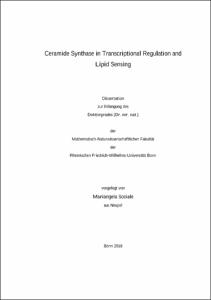Ceramide Synthase in Transcriptional Regulation and Lipid Sensing

Ceramide Synthase in Transcriptional Regulation and Lipid Sensing

| dc.contributor.advisor | Bauer, Reinhard | |
| dc.contributor.author | Sociale, Mariangela | |
| dc.date.accessioned | 2020-04-26T13:07:37Z | |
| dc.date.available | 2020-04-26T13:07:37Z | |
| dc.date.issued | 20.05.2019 | |
| dc.identifier.uri | https://hdl.handle.net/20.500.11811/7921 | |
| dc.description.abstract | Ceramide synthases (CerS) are highly conserved transmembrane proteins necessary for sphingolipid biosynthesis. CerSs carry a TLC (Tram-Lag1-CLN8) domain, containing a conserved Lag1p motif required for ceramide synthesis. Many of the CerS enzymes also contain a homeodomain. Although homeodomain proteins are known to regulate transcription via DNA binding, the homeodomain function of CerSs is frequently not investigated and previous studies doubted that it could act as a transcription factor. Recently, it has been shown that the Drosophila homologous of CerS called "Schlank", is not only involved in sphingolipid biosynthesis but also in the regulation of body fat. Moreover, the regulation of body fat is independent of CerS activity. Besides localizing at the endoplasmic reticulum, as each mammalian CerSs, Schlank also localizes at the inner nuclear membrane (INM). Two nuclear localization sites (NLS1, NLS2) are necessary for the nuclear localization of the protein. In order to distinguish the homeodomain function from the catalytic one, in vivo homeodomain animal models were generated and analyzed. The mutation in the NLS2 site severely affected lipolysis and development, demonstrating an essential function of the Schlank homeodomain in the regulation of body fat metabolism and growth. This work shows that Schlank binds the promoter regions of lipases (e.g., lip3) via the homeodomain and directly regulates transcription. Mutations of the NLS2 site led to loss of DNA binding and deregulated gene expression. This mechanism seems to be conserved in mammalian CerS2. Furthermore, Schlank adjusts transcriptional regulation according to the energy status. Upon starvation, nuclear localization and consequently DNA binding diminish. On the other hand, Schlank responds to changing fatty acid levels (essential molecules in sphingolipid biosynthesis), increasing nuclear localization and regulating gene expression. This study demonstrates a double function of CerS Schlank as an enzyme and a transcriptional regulator, sensing lipid levels and transducing the information to the level of gene expression. This function is required to adjust and maintain lipid homeostasis. | en |
| dc.description.abstract | Ceramid-Synthasen (CerS) sind hochkonservierte Transmembranproteine, die für die Sphingolipid-Biosynthese notwendig sind. CerSs tragen eine TLC (Tram-Lag1-CLN8)-Domäne, die ein konserviertes Lag1p-Motiv enthält, das für die Ceramidsynthese erforderlich ist. Viele der CerS-Enzyme enthalten auch eine Homöodomäne. Obwohl Homöodomain-Proteine bekanntermaßen die Transkription über die DNA-Bindung regulieren, ist die Homöodomain-Funktion von CerSs nicht genau untersucht und frühere Studien bezweifelten sogar, dass sie als Transkriptionsfaktor fungieren könnte. In jüngster Zeit konnte gezeigt werden, dass das Drosophila-Homolog namens "Schlank" nicht nur in der Sphingolipidbiosynthese, sondern auch in der Regulation von Körperfett involviert ist. Die Regulierung des Körperfettanteils ist zudem unabhängig von der CerS-Aktivität. Neben der Lokalisierung am Endoplasmatischen Retikulum, wie auch die Säuger CerS, ist Schlank auch an der inneren Kernmembran (INM) lokalisiert. Zwei nukleare Lokalisierungsstandorte (NLS1, NLS2) sind für die nukleare Lokalisierung des Proteins notwendig. Um die Homöodomänenfunktion von der katalytischen zu unterscheiden, wurden in vivo Homöodomänen-Fliegenmodelle generiert und analysiert. Die Mutation am NLS2-Standort wirkte sich stark auf die Lipolyse und Entwicklung aus und demonstrierte eine wesentliche Funktion der Schlank-Heimatdomäne bei der Regulierung des Körperfettstoffwechsels und des Wachstums. Diese Arbeit zeigt, dass Schlank die Promotor-Regionen von Lipasen (z.B. Lip3) über die Homöodomäne bindet und die Transkription direkt reguliert. Mutationen des NLS2-Standortes führten zum Verlust der DNA-Bindung und deregulierten Genexpression. Dieser Mechanismus scheint im Säuger CerS2 konserviert zu sein. Darüber hinaus passt Schlank die Transkriptionsregulation an den Energiestatus an. Werden die Fliegen gehungert nimmt die nukleare Lokalisation und damit die Bindung an die DNA ab. Auf der anderen Seite reagiert Schlank auf sich ändernde Fettsäurespiegel (essentielle Moleküle in der Sphingolipidbiosynthese), erhöht die nukleare Lokalisation und reguliert die Genexpression. Diese Studie demonstriert eine Doppelfunktion von CerS Schlank als Enzym und Transkriptionsregulator, indem sie den Lipidspiegel misst und die Informationen auf die Ebene der Genexpression transformiert. Diese Funktion ist erforderlich, um die Lipid-Homöostase zu regulieren und aufrechtzuerhalten. | en |
| dc.language.iso | eng | |
| dc.rights | In Copyright | |
| dc.rights.uri | http://rightsstatements.org/vocab/InC/1.0/ | |
| dc.subject | Ceramid-Synthasen | |
| dc.subject | Sphingolipid-Biosynthese | |
| dc.subject | Homöodomain-Funktion | |
| dc.subject | DNA-Bindung | |
| dc.subject | Lipid-Homöostase | |
| dc.subject | Ceramide Synthase | |
| dc.subject | Sphingolipid biosynthesis | |
| dc.subject | Homeodomain Function | |
| dc.subject | DNA binding | |
| dc.subject | Lipid Homeostasis | |
| dc.subject.ddc | 570 Biowissenschaften, Biologie | |
| dc.title | Ceramide Synthase in Transcriptional Regulation and Lipid Sensing | |
| dc.type | Dissertation oder Habilitation | |
| dc.publisher.name | Universitäts- und Landesbibliothek Bonn | |
| dc.publisher.location | Bonn | |
| dc.rights.accessRights | openAccess | |
| dc.identifier.urn | https://nbn-resolving.org/urn:nbn:de:hbz:5n-54540 | |
| ulbbn.pubtype | Erstveröffentlichung | |
| ulbbnediss.affiliation.name | Rheinische Friedrich-Wilhelms-Universität Bonn | |
| ulbbnediss.affiliation.location | Bonn | |
| ulbbnediss.thesis.level | Dissertation | |
| ulbbnediss.dissID | 5454 | |
| ulbbnediss.date.accepted | 12.04.2019 | |
| ulbbnediss.institute | Mathematisch-Naturwissenschaftliche Fakultät : Fachgruppe Molekulare Biomedizin / Life & Medical Sciences-Institut (LIMES) | |
| ulbbnediss.fakultaet | Mathematisch-Naturwissenschaftliche Fakultät | |
| dc.contributor.coReferee | Tavosanis, Gaia |
Dateien zu dieser Ressource
Das Dokument erscheint in:
-
E-Dissertationen (4462)




